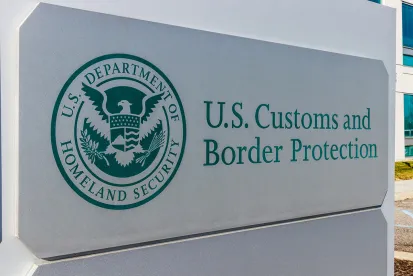In our previous biweekly update on What Every Multinational Needs to Know About … The Uyghur Forced Labor Prevention Act, Part I, we summarized the UFLPA requirements and the basic expectations that U.S. Customs and Border Protection (CBP) has set forth for importers that are potentially impacted by the Act. In this post, we provide a detailed set of model UFLPA due diligence and risk-management strategies for importers at risk of UFLPA detentions. Although these suggested compliance steps are aimed primarily at minimizing the risk of UFLPA detentions, many of these steps also are useful for minimizing the risk of forced labor and human trafficking violations, which also require intimate knowledge of your supply chain, right down to the last sub-supplier. A well-designed supply chain integrity program will address all elements of supply chain risk, including forced labor, human trafficking, UFLPA, supply chain transparency requirements, conflict minerals, and other potentially applicable regulatory risks.
The following compliance steps will vary for each importer, based on its own, unique risk profile. Nonetheless, the key general compliance and due diligence items to consider include the following steps to consider for importers who are at heightened risk of UFLPA detentions.
Step 1: Map Your Supply Chain
- You should map out your supply chain, including sub-suppliers (and their sub-suppliers), to ensure that you have identified potential risk points relating to potential sourcing from the Xianjiang Uyghur Autonomous Region (XUAR). The review should cover the origin of the imported goods and any raw materials or components in the imported goods. Items to consider in your mapping exercise include:
- Identifying transactions among entities along the supply chain tied to the specific imported goods.
- Identifying locations and identities of entities in the supply chain, their sub-suppliers, and their business relationships.
- You should use publicly available resources to estimate the probability that raw materials or components originated in the XUAR.
- You should be alert to red flags that could indicate the use of unauthorized sub-suppliers, such as the sourcing of raw materials or components that do not originate from the stated location or inputs from countries that are known to lack production capacity.
Step 2: Conduct Due Diligence on Key Suppliers
- Due diligence is a key component of UFLPA compliance. Key items to consider in your UFLPA due diligence strategy include a detailed description of the supply chain for the imported good and its components, including ties to the supply chain map.
- Due diligence should include documentation regarding how: (1) the imported good was made from raw materials to finished good; (2) by what entities (and where), including all in-house manufacturing, sub-assembly operations, and outsourced production related to the imported good; (3) the roles of the entities involved at each stage of the supply chain; and (4) the relationship between the entities, including whether a supplier also is a manufacturer.
- For goods originating in China or that rely on Chinese parts and components, which are at higher risk, there should be due diligence conducted to show there are no links to the XUAR, to companies on the UFLPA Entity List, or other links to the use of labor linked to the XUAR.
- Because UFLPA compliance is related to general forced labor and human trafficking concerns, due diligence also should focus on general indicators of forced labor, including intimidation and threats, abuse or vulnerability, restriction of movement, isolation, substandard living and/or working conditions, and excessive hours. Evidence may include the following:
- The previously mentioned supply chain map.
- Evidence to demonstrate how and to whom wages are paid at each supplier and sub-supplier.
- Evidence regarding whether the worker comes from the XUAR and the worker’s residency status.
- Evidence to demonstrate that production of the goods is consistent with the documented workers, including their number, the total materials produced, and the total volume of output.
- Information relating to hours worked and the output of the relevant goods.
- Evidence that none of the workers was recruited, transported, transferred, harbored, or received with the involvement of the Chinese government, XPCC, or entities on the UFLPA Entity List.
- Information showing the supplier and sub-suppliers have controls in place to ensure all workers are voluntarily recruited.
- Evidence demonstrating that any worker from the XUAR is working voluntarily and without threat of penalty, including credible evidence that each worker:
- Was fully voluntarily recruited to work.
- Was recruited and continued at the job without coercion.
- Was recruited free of any forced labor indicator, including detention, threats of detention, detention or threats of detention of family members, or forced transfer of land to the government.
- Was transported from the XUAR voluntarily and free of any forced labor indicator, including government surveillance or control of worker movements.
- Was transferred to the entity in a voluntary fashion, free of any forced labor indicator, including government surveillance.
- Was living and working in conditions free of any forced labor indicator, including government surveillance, reporting to the government, restriction of movement, or required indoctrination activities such as political, language, or cultural classes.
Step 3: Ensure Due Diligence and Compliance Extend to Sub-Suppliers
- Because both the UFLPA and forced labor liability under other regulations can arise from activities by sub-suppliers, it is essential to identify the provenance of each component of the imported good.
- Due to this possibility, supply-chain mapping should work through to the last sub-supplier. This requires working with suppliers to identify sub-suppliers who might not be known to your company.
- When possible, you should use unique identifiers to track raw materials and other inputs through the supply chain. This may require the use of tracking methodologies to deal with inputs from different suppliers that might be commingled.
Step 4: Develop Legal Protections
- Appropriate forced labor and UFLPA risk management requires adopting a layered approach to compliance. One of the layers of protection lies in the adoption of appropriate legal protections.
- A key first step is to develop a vendor code of conduct, which lays out the legal obligations that govern the relationship with suppliers as well as the contractual obligations to abide by all ethical sourcing contractual provisions.
- For supply chains that potentially have some kind of link to the XUAR, involve entities that use labor transferred from the XUAR under government labor programs, or source parts and components that may do the same, the code of conduct should specifically address the risk of using such government labor schemes, including pairing assistance, poverty alleviation, or other labor transfer programs that may implicate the ULFPA. The vendor code of conduct should also cover the requirement not to use any companies on the UFLPA Entity List.
- As part of a layered approach to compliance, you should incorporate the code of conduct into all supplier contracts, whether through explicit contractual provisions in long-term agreements and purchase orders or through incorporation of the vendor code of conduct requirements by reference. These provisions should include not only the legal obligation to comply with forced labor and UFLPA regulations but also incorporate such compliance measures as allowing auditors and verification organizations necessary access to facilities.
- Your legal agreement with your suppliers should require that they flow down all forced labor, human trafficking, and UFLPA compliance requirements to all of their suppliers. The flow-down requirements should mirror the strength of your own code of conduct and should require that your direct supplier (1) ensure that sub-suppliers train employees on detecting forced labor, (2) conduct self-audits or obtain independent audits (including regarding recruitment of workers and use of government labor programs), (3) track and report on their performance of these compliance requirements, and (4) require and monitor subcontractor adherence to the code of conduct.
Step 5: Communicate and Train Across the Supply Chain
- You should provide training to employees or agents responsible for selecting suppliers, including regarding (1) the conduct of a forced labor/UFLPA risk assessment, (2) identifying the risks of forced labor identified by risk assessments, (3) the legal restrictions and consequences of importing into the United States goods produced with forced labor, (4) the presumption that goods made in the XUAR or by companies on the Entity List are made using forced labor, (5) the risks posed by products that incorporate goods using forced or UFLPA labor, (6) the risks of suppliers being included on future additions to the UFLPA Entity List, and (7) the requirements of the company’s code of conduct.
- You should communicate the applicable legal and contractual requirements to suppliers at all tiers of the supply chain.
- You should provide training regarding forced labor, human trafficking, and UFLPA issues to all of your key suppliers while also providing such training to sub-suppliers or requiring such training from your own suppliers.
Step 6: Monitor Compliance
- You should monitor supplier compliance with the code of conduct, particularly for those suppliers and subcontractors in the XUAR that source from the XUAR or that are on the UFLPA Entity List.
- You should remediate any forced labor conditions or UFLPA violations and terminate the supplier relationship if remediation is not possible or is not timely completed.
Step 7: Remediate Compliance Missteps
- If indicators signifying the presence of forced labor in the supply chain are identified, or violations of the UFLPA identified, you should cease importing impacted goods prior to remediation. If you intend to continue sourcing inputs from the supplier, you must develop a corrective action plan that specifically addresses all indicators of forced labor or eliminates the UFLPA concerns.
- You should consider using, on a risk-adjusted basis, independent third-party verification regarding the effectiveness of an importer’s due diligence system. Third-party verification also can be helpful in periodically assessing the effectiveness of system components for ensuring that the supply chain is free of forced labor.
Step 8: Be Prepared Before Importation
- You should inform relevant import stakeholders about the importance of due diligence and investigation into potential risky suppliers.
- You should monitor online news sources for possible risks, news, or complaints involving the products or suppliers flagged as high risk.
- You should be ready for a possible CBP detention, including by having all documents for the entire supply chain ready and informing your suppliers of the potential need to quickly respond to CBP inquiries.
- When handling a high-risk import, consider contacting the relevant CBP Center of Excellence and Expertise before the goods arrive at the U.S. port of entry. It is possible to submit a complete documentation package before arrival — and perhaps as early as when the shipment leaves the foreign port — as a means of facilitating CBP’s review.






 />i
/>i
